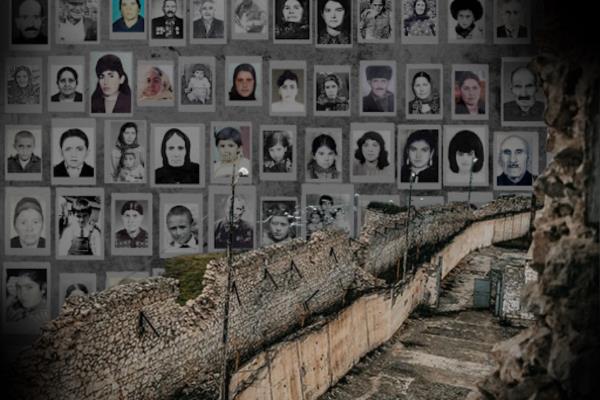
4K Missing Azerbaijanis Remain Unknown As World Yet To Hold Armenia Accountable
Despite the end of the long-standing Armenian occupation in the South Caucasus through the determination of the Azerbaijani army in 2020 and 2023, traces of Armenian vandalism still persist in the region. The most horrifying of these traces is the unknown fate of thousands of missing Azerbaijanis. Since the 1990s, the ethnic cleansing policy against the Azerbaijani people has resulted in the displacement of 1 million people from their homes and the disappearance of 4,000 individuals. The total number of Azerbaijanis brutally killed in massacres like Khojaly and Meshali, as well as on the battlefield, reached 16,000.
Today, a two-day international conference titled "Solving the Problem of Missing Persons: Supporting Families' Right to Know the Truth" was commenced in Baku, jointly organised by the State Commission on Prisoners of War, Hostages, and Missing Persons and the International Committee of the Red Cross (ICRC).
In his address to the conference participants, Azerbaijani President Ilham Aliyev highlighted the Armenian atrocities that came to light after the liberation of Garabagh. He stated that exhumation work at the mass graves discovered after the liberation of Garabagh revealed the violence and inhumane torture inflicted by Armenians on Azerbaijani prisoners. The fact that Azerbaijanis were held hostage and tortured to death in the Shusha prison was also emphasised in the president's speech.
The Horrors Awaiting Prisoners in Shusha Prison
Shusha Prison is remembered as a symbol of the severe torture and atrocities inflicted on Azerbaijani prisoners and civilians by Armenian forces during the period of Armenia's occupation of the city of Shusha from 1992-1993. Due to its strategic significance, Shusha was of particular interest to Armenia. During this time, widespread violations of human rights were carried out against Azerbaijani prisoners and civilians in Shusha Prison.
Former prisoners were subjected to severe physical and psychological torture, kept in conditions of extreme hunger and thirst, and subjected to violence. The conditions in the prison were so dire that they insulted human dignity, with prisoners being treated inhumanely. Armenian forces held prisoners under both physical and psychological pressure, trying to coerce them into making forced confessions or collaborating against the Azerbaijani government.
These events are a traumatic memory for the Azerbaijani people and have turned the prison into a symbol of human rights violations during the war. After Shusha's liberation in 2020, a thorough investigation and documentation of these incidents became one of the critical steps. As a result of these investigations, many mass graves were discovered around the prison. Last year, Zaur Ismayilov, an employee of the working group of the State Commission on Prisoners of War, Hostages, and Missing Persons, reported that the fate of over 140 individuals held in Shusha Prison remains unknown. In total, 360 prisoners and hostages were held in Shusha Prison. These facts reflect Armenia's disregard for both the laws of war and human rights.
The mass graves discovered in Azerbaijan's liberated areas, such as Khojaly, Kalbajar, Khojavand, and Aghdam, are enough to show the scale of Armenian vandalism and inhumane practices. According to the Criminalistics Department of the Azerbaijani Prosecutor General's Office, at least 172 bodies have been discovered in these mass graves as of April this year.
The identities of these bodies are still being investigated, and many have been revealed.
The Tragedy of Natig Gasimov
Among the missing Azerbaijanis, one of the most heroic figures is Azerbaijan's national hero Natig Gasimov. In addition to actively participating in the battles for Khojaly, he sacrificed his life to save 21 Khojaly residents.
Vitali Balasanyan, one of the leaders of the Garabagh separatists, who was among those who captured him, has so far refused to provide any information about Natig's fate. Former soldiers who served under his command have admitted in various media outlets that Natig was "punished" with a brutal death.
Natig's relatives, along with those of other Azerbaijani soldiers and civilians whose fate remains unknown, continue to wait for their return. Some simply wish for a proper grave for their loved ones.
Azerbaijan, as a responsible member of the international community, views the issue of missing persons during armed conflicts not only as part of its problem but also as a global issue faced by many countries. As President Ilham Aliyev stated, Azerbaijan introduces a resolution on the issue of missing persons at the UN General Assembly every two years, which is adopted by consensus.
Undoubtedly, these efforts will continue until justice is served. The Azerbaijani government will persist in its efforts to determine the fate of nearly 4,000 missing persons, including Natig Gasimov.
Currently, part of the ongoing peace negotiations between Azerbaijan and Armenia includes the demand for precise information about the fate of missing persons to be handed over to Baku. However, Armenia, as with other conditions, is incapable of meeting this demand. The country's leadership, marked by indiscipline and vandalism, shows inhumane treatment not only to prisoners but also to its own soldiers. Photographs of Armenian soldiers left to die in shackles by their commanders, discovered by Azerbaijani servicemen during the Second Garabagh War, serve as evidence of this.
Legal Disclaimer:
MENAFN provides the
information “as is” without warranty of any kind. We do not accept
any responsibility or liability for the accuracy, content, images,
videos, licenses, completeness, legality, or reliability of the information
contained in this article. If you have any complaints or copyright
issues related to this article, kindly contact the provider above.


















Comments
No comment